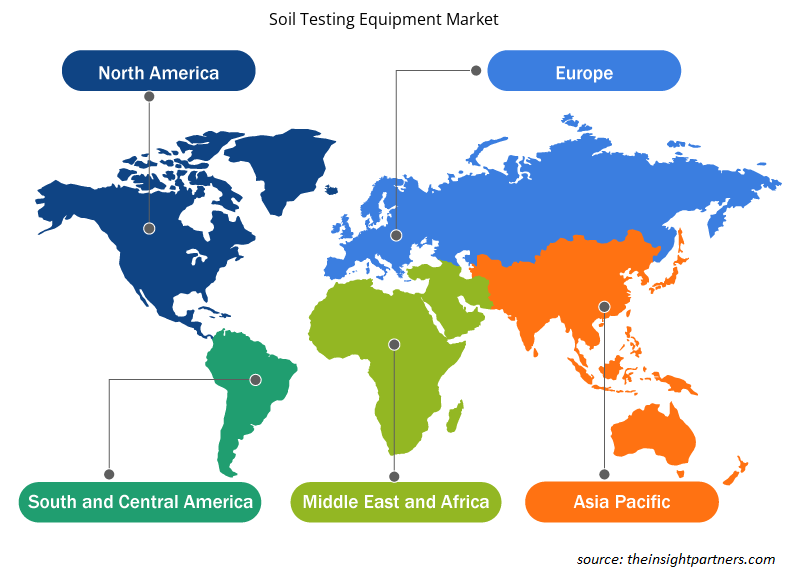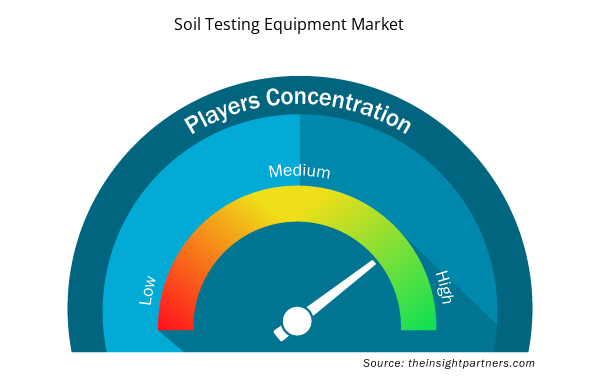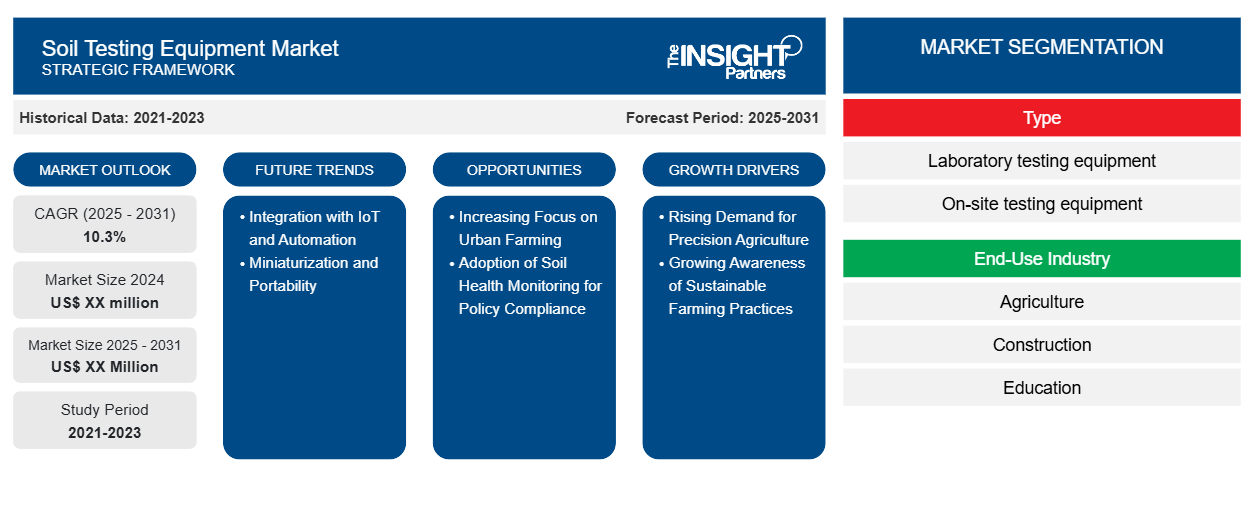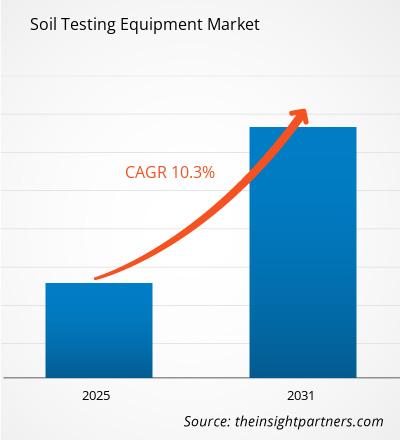土壌検査装置市場は、2024年から2031年にかけて10.3%のCAGRで成長し、市場規模は2024年のXX百万米ドルから2031年にはXX百万米ドルに拡大すると予想されています。
レポートは、タイプ(実験室試験装置、オンサイト試験装置)、最終用途産業(農業、建設、教育、その他)別にセグメント化されています。グローバル分析は、地域レベルと主要国でさらに細分化されています。レポートは、上記の分析とセグメントに対して米ドルでの価値を提供します。
報告書の目的
The Insight Partners によるレポート「土壌試験装置市場」は、現在の状況と将来の成長、主な推進要因、課題、機会を説明することを目的としています。これにより、次のようなさまざまなビジネス関係者に洞察が提供されます。
- テクノロジープロバイダー/メーカー: 進化する市場の動向を理解し、潜在的な成長機会を把握することで、情報に基づいた戦略的意思決定が可能になります。
- 投資家: 市場の成長率、市場の財務予測、バリュー チェーン全体に存在する機会に関する包括的な傾向分析を実施します。
- 規制機関: 市場の濫用を最小限に抑え、投資家の信用と信頼を維持し、市場の完全性と安定性を維持することを目的として、市場における政策と警察活動を規制します。
土壌検査機器市場のセグメンテーション
タイプ
- 実験室試験装置
- 現場試験装置
最終用途産業
- 農業
- 工事
- 教育
- その他
要件に合わせてレポートをカスタマイズする
このレポートの一部、国レベルの分析、Excelデータパックなど、あらゆるレポートを無料でカスタマイズできます。また、スタートアップや大学向けのお得なオファーや割引もご利用いただけます。
- このレポートの主要な市場動向を入手してください。この無料サンプルには、市場動向から見積もりや予測に至るまでのデータ分析が含まれます。
土壌検査機器市場の成長要因
- 精密農業の需要の高まり: 精密農業が世界的に普及するにつれ、高度な土壌検査機器の必要性が高まっています。農家は、作物の収穫量を最適化するために、土壌の健康状態、栄養レベル、水分含有量を監視する技術を導入する傾向が高まっています。土壌検査機器は、より正確でデータに基づいた意思決定を可能にし、生産性と持続可能性を向上させ、これらのツールの市場を牽引しています。
- 持続可能な農業慣行に対する意識の高まり: 持続可能で環境に優しい農業慣行の推進により、土壌検査機器の需要が高まっています。農家は、化学物質の使用を減らし、土壌の劣化を防ぎ、管理の改善によって土壌の肥沃度を高めることに重点を置いています。定期的な土壌検査により、輪作、施肥、灌漑について十分な情報に基づいた決定を下すことができ、持続可能な農業が促進されます。
土壌検査機器市場の将来動向
- IoT と自動化との統合: 土壌検査機器には IoT テクノロジーと自動化がますます取り入れられており、リアルタイムの監視とデータ収集が可能になっています。これらのスマート ツールは、農家が土壌の状態を迅速に分析し、灌漑および施肥システムを自動的に調整し、作物の成長を最適化するのに役立ちます。IoT との統合により、土壌の健康状態の管理方法が変革され、高度な機器の導入が促進されています。
- 小型化と携帯性: 土壌検査市場では、携帯可能なコンパクトな土壌検査装置の開発がトレンドになっています。これらの装置は現場での使いやすさを実現し、農家や農業専門家はサンプルを研究所に送ることなく、迅速かつ正確に検査を行うことができます。携帯性という要素により、特に遠隔地の農業地域では土壌検査がより身近なものになっています。
土壌検査機器の市場機会
- 都市農業への注目の高まり: 屋上庭園や垂直農場などの都市農業の取り組みは、特に大都市圏で人気が高まっています。これらの環境では、最適な作物生産のために正確な土壌管理が必要です。都市農業アプリケーションにおけるコンパクトで使いやすい土壌検査機器の需要は、市場にとって新たな機会です。
- 政策遵守のための土壌健全性モニタリングの導入: 政府は、持続可能な農業慣行と環境基準への準拠を確保するために、土壌健全性モニタリングを義務付ける政策を導入しています。この規制の推進により、高度な土壌検査機器の必要性が生まれ、世界中で農業慣行の規制が強化されるにつれて、市場が成長するチャンスが生まれます。
土壌検査機器市場の地域別分析
予測期間を通じて土壌試験装置市場に影響を与える地域的な傾向と要因は、Insight Partners のアナリストによって徹底的に説明されています。このセクションでは、北米、ヨーロッパ、アジア太平洋、中東およびアフリカ、南米および中米にわたる土壌試験装置市場のセグメントと地理についても説明します。

- 土壌検査機器市場の地域別データを入手
土壌検査機器市場レポートの範囲
| レポート属性 | 詳細 |
|---|---|
| 2024年の市場規模 | XX百万米ドル |
| 2031年までの市場規模 | XX百万米ドル |
| 世界のCAGR(2025年~2031年) | 10.3% |
| 履歴データ | 2021-2023 |
| 予測期間 | 2025-2031 |
| 対象セグメント | タイプ別
|
| 対象地域と国 | 北米
|
| 市場リーダーと主要企業プロフィール |
|
土壌検査機器市場のプレーヤー密度:ビジネスダイナミクスへの影響を理解する
土壌検査機器市場は、消費者の嗜好の変化、技術の進歩、製品の利点に対する認識の高まりなどの要因により、エンドユーザーの需要が高まり、急速に成長しています。需要が高まるにつれて、企業は提供を拡大し、消費者のニーズを満たすために革新し、新たなトレンドを活用し、市場の成長をさらに促進しています。
市場プレーヤー密度とは、特定の市場または業界内で活動している企業または会社の分布を指します。これは、特定の市場スペースに、その規模または総市場価値と比較して、どれだけの競合相手 (市場プレーヤー) が存在するかを示します。
土壌検査装置市場で事業を展開している主要企業は次のとおりです。
- ALFA | 試験装置
- アジレントテクノロジー
- SpAをコントロール
- サーモフィッシャーサイエンティフィック
- ELEインターナショナル
免責事項:上記の企業は、特定の順序でランク付けされていません。

- 土壌検査機器市場のトップキープレーヤーの概要を入手
主なセールスポイント
- 包括的なカバレッジ: レポートでは、土壌検査装置市場の製品、サービス、タイプ、エンドユーザーの分析を包括的にカバーし、全体的な展望を提供します。
- 専門家による分析: レポートは、業界の専門家とアナリストの深い理解に基づいてまとめられています。
- 最新情報: このレポートは、最新の情報とデータの傾向を網羅しているため、ビジネスの関連性を保証します。
- カスタマイズ オプション: このレポートは、特定のクライアント要件に対応し、ビジネス戦略に適切に適合するようにカスタマイズできます。
したがって、土壌試験装置市場に関する調査レポートは、業界のシナリオと成長の見通しを解読し理解する道の先導役となることができます。正当な懸念事項がいくつかあるかもしれませんが、このレポートの全体的な利点は欠点を上回る傾向があります。
- 過去2年間の分析、基準年、CAGRによる予測(7年間)
- PEST分析とSWOT分析
- 市場規模価値/数量 - 世界、地域、国
- 業界と競争環境
- Excel データセット



Report Coverage
Revenue forecast, Company Analysis, Industry landscape, Growth factors, and Trends

Segment Covered
This text is related
to segments covered.

Regional Scope
North America, Europe, Asia Pacific, Middle East & Africa, South & Central America

Country Scope
This text is related
to country scope.
よくある質問
Some of the customization options available based on the request are an additional 3-5 company profiles and country-specific analysis of 3-5 countries of your choice. Customizations are to be requested/discussed before making final order confirmation# as our team would review the same and check the feasibility
IoT and Smart Sensors Integration is likely to remain a key trend in the market.
Key players in the soil testing equipment market include ALFA I Testing Equipment, Agilent Technologies, Controls S_p.A, Thermo Fisher Scientific Inc, ELE International, Merck KGaA, PerkinElmer Inc, MATEST, LaMotte Company, and Geotechnical Testing Equipment UK Ltd
The major factors driving the soil testing equipment market are:
1. Growing Demand for Precision Agriculture.
2.Government Regulations and Environmental Concerns
The Soil Testing Equipment Market is estimated to witness a CAGR of 10.3% from 2023 to 2031
Trends and growth analysis reports related to Electronics and Semiconductor : READ MORE..
The List of Companies
- ALFA | Testing Equipment
- Agilent Technologies
- Controls S.p.A.
- Thermo Fisher Scientific Inc
- ELE International
- Merck KGaA
- PerkinElmer Inc
- MATEST
- LaMotte Company
- Geotechnical Testing Equipment UK Ltd
The Insight Partners performs research in 4 major stages: Data Collection & Secondary Research, Primary Research, Data Analysis and Data Triangulation & Final Review.
- Data Collection and Secondary Research:
As a market research and consulting firm operating from a decade, we have published and advised several client across the globe. First step for any study will start with an assessment of currently available data and insights from existing reports. Further, historical and current market information is collected from Investor Presentations, Annual Reports, SEC Filings, etc., and other information related to company’s performance and market positioning are gathered from Paid Databases (Factiva, Hoovers, and Reuters) and various other publications available in public domain.
Several associations trade associates, technical forums, institutes, societies and organization are accessed to gain technical as well as market related insights through their publications such as research papers, blogs and press releases related to the studies are referred to get cues about the market. Further, white papers, journals, magazines, and other news articles published in last 3 years are scrutinized and analyzed to understand the current market trends.
- Primary Research:
The primarily interview analysis comprise of data obtained from industry participants interview and answers to survey questions gathered by in-house primary team.
For primary research, interviews are conducted with industry experts/CEOs/Marketing Managers/VPs/Subject Matter Experts from both demand and supply side to get a 360-degree view of the market. The primary team conducts several interviews based on the complexity of the markets to understand the various market trends and dynamics which makes research more credible and precise.
A typical research interview fulfils the following functions:
- Provides first-hand information on the market size, market trends, growth trends, competitive landscape, and outlook
- Validates and strengthens in-house secondary research findings
- Develops the analysis team’s expertise and market understanding
Primary research involves email interactions and telephone interviews for each market, category, segment, and sub-segment across geographies. The participants who typically take part in such a process include, but are not limited to:
- Industry participants: VPs, business development managers, market intelligence managers and national sales managers
- Outside experts: Valuation experts, research analysts and key opinion leaders specializing in the electronics and semiconductor industry.
Below is the breakup of our primary respondents by company, designation, and region:

Once we receive the confirmation from primary research sources or primary respondents, we finalize the base year market estimation and forecast the data as per the macroeconomic and microeconomic factors assessed during data collection.
- Data Analysis:
Once data is validated through both secondary as well as primary respondents, we finalize the market estimations by hypothesis formulation and factor analysis at regional and country level.
- Macro-Economic Factor Analysis:
We analyse macroeconomic indicators such the gross domestic product (GDP), increase in the demand for goods and services across industries, technological advancement, regional economic growth, governmental policies, the influence of COVID-19, PEST analysis, and other aspects. This analysis aids in setting benchmarks for various nations/regions and approximating market splits. Additionally, the general trend of the aforementioned components aid in determining the market's development possibilities.
- Country Level Data:
Various factors that are especially aligned to the country are taken into account to determine the market size for a certain area and country, including the presence of vendors, such as headquarters and offices, the country's GDP, demand patterns, and industry growth. To comprehend the market dynamics for the nation, a number of growth variables, inhibitors, application areas, and current market trends are researched. The aforementioned elements aid in determining the country's overall market's growth potential.
- Company Profile:
The “Table of Contents” is formulated by listing and analyzing more than 25 - 30 companies operating in the market ecosystem across geographies. However, we profile only 10 companies as a standard practice in our syndicate reports. These 10 companies comprise leading, emerging, and regional players. Nonetheless, our analysis is not restricted to the 10 listed companies, we also analyze other companies present in the market to develop a holistic view and understand the prevailing trends. The “Company Profiles” section in the report covers key facts, business description, products & services, financial information, SWOT analysis, and key developments. The financial information presented is extracted from the annual reports and official documents of the publicly listed companies. Upon collecting the information for the sections of respective companies, we verify them via various primary sources and then compile the data in respective company profiles. The company level information helps us in deriving the base number as well as in forecasting the market size.
- Developing Base Number:
Aggregation of sales statistics (2020-2022) and macro-economic factor, and other secondary and primary research insights are utilized to arrive at base number and related market shares for 2022. The data gaps are identified in this step and relevant market data is analyzed, collected from paid primary interviews or databases. On finalizing the base year market size, forecasts are developed on the basis of macro-economic, industry and market growth factors and company level analysis.
- Data Triangulation and Final Review:
The market findings and base year market size calculations are validated from supply as well as demand side. Demand side validations are based on macro-economic factor analysis and benchmarks for respective regions and countries. In case of supply side validations, revenues of major companies are estimated (in case not available) based on industry benchmark, approximate number of employees, product portfolio, and primary interviews revenues are gathered. Further revenue from target product/service segment is assessed to avoid overshooting of market statistics. In case of heavy deviations between supply and demand side values, all thes steps are repeated to achieve synchronization.
We follow an iterative model, wherein we share our research findings with Subject Matter Experts (SME’s) and Key Opinion Leaders (KOLs) until consensus view of the market is not formulated – this model negates any drastic deviation in the opinions of experts. Only validated and universally acceptable research findings are quoted in our reports.
We have important check points that we use to validate our research findings – which we call – data triangulation, where we validate the information, we generate from secondary sources with primary interviews and then we re-validate with our internal data bases and Subject matter experts. This comprehensive model enables us to deliver high quality, reliable data in shortest possible time.


 このレポートの無料サンプルを入手する
このレポートの無料サンプルを入手する